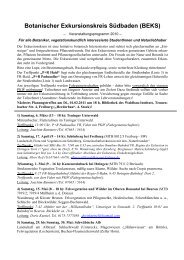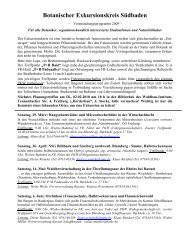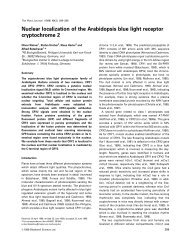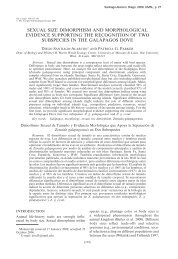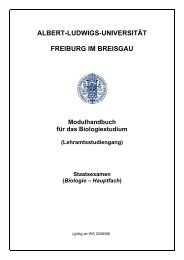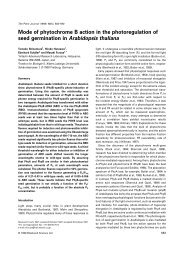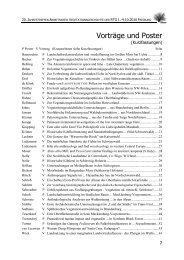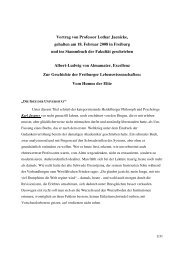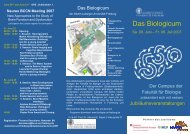Light-controlled growth of the maize seedling mesocotyl: Mechanical ...
Light-controlled growth of the maize seedling mesocotyl: Mechanical ...
Light-controlled growth of the maize seedling mesocotyl: Mechanical ...
You also want an ePaper? Increase the reach of your titles
YUMPU automatically turns print PDFs into web optimized ePapers that Google loves.
PHYSIOLOGIA PLANTARUM 111: 83–92. 2001 Copyright © Physiologia Plantarum 2001<br />
Printed in Ireland—all rights resered<br />
ISSN 0031-9317<br />
<strong>Light</strong>-<strong>controlled</strong> <strong>growth</strong> <strong>of</strong> <strong>the</strong> <strong>maize</strong> <strong>seedling</strong> <strong>mesocotyl</strong>: <strong>Mechanical</strong><br />
cell-wall changes in <strong>the</strong> elongation zone and related changes in<br />
lignification<br />
Peter Schopfer a, *, Ca<strong>the</strong>rine Lapierre b and Titus Nolte a<br />
aInstitut für Biologie II der Uniersität, Schänzlestr. 1, D-79104 Freiburg, Germany<br />
bLaboratoire de Chimie Biologique, INRA-CBAI, Institut National Agronomique, Centre de Grignon, F-78850 Thieral-Grignon, France<br />
*Corresponding author, e-mail: schopfer@uni-freiburg.de<br />
Received 15 June 2000<br />
Cell extension in <strong>the</strong> <strong>mesocotyl</strong> elongation zone (MEZ) <strong>of</strong> <strong>growth</strong> inhibition induced by 3 h light. In <strong>the</strong> vascular bundle<br />
<strong>maize</strong> (Zea mays L.) <strong>seedling</strong>s is inhibited by light. The light produces no comparable change in lignin content. Ap-<br />
<strong>growth</strong> inhibition by blue light in <strong>the</strong> MEZ was reversible pearance and disappearance <strong>of</strong> phenylpropanoid material in<br />
upon transfer to darkness. This experimental system was used MEZ cell walls in <strong>the</strong> light, or in darkness following a brief<br />
for investigating <strong>the</strong> modification <strong>of</strong> mechanical cell-wall prop- light treatment, respectively, can be visualized under <strong>the</strong><br />
erties and <strong>the</strong> role <strong>of</strong> cell-wall lignification in cell elongation. fluorescence microscope by characteristic changes in<br />
The occurrence <strong>of</strong> lignin in <strong>the</strong> cortex and vascular bundle aut<strong>of</strong>luorescence <strong>of</strong> tissue sections upon excitation with UV<br />
tissues <strong>of</strong> <strong>the</strong> MEZ was demonstrated by <strong>the</strong> isolation <strong>of</strong> radiation. It is concluded from <strong>the</strong>se results that light-induced<br />
diagnostic monomers released after thioacidolysis <strong>of</strong> <strong>the</strong> cell lignification <strong>of</strong> primary walls is involved in cell-wall stiffening<br />
walls. Concomitantly with <strong>the</strong> inhibition <strong>of</strong> <strong>growth</strong>, blue light and thus inhibition <strong>of</strong> elongation <strong>growth</strong> in <strong>the</strong> MEZ <strong>of</strong> <strong>maize</strong><br />
induces an increase in cell-wall stiffness (tensile modulus) as <strong>seedling</strong>s. Resumption <strong>of</strong> <strong>growth</strong> upon redarkening may be<br />
well as an increase in extractable lignin in <strong>the</strong> outer MEZ initiated by wall loosening in <strong>the</strong> uppermost MEZ region<br />
tissues (cortex+epidermis). Both effects are reversed when which displaces <strong>the</strong> lignified cell walls towards <strong>the</strong> lower<br />
<strong>growth</strong> is resumed in <strong>the</strong> MEZ in darkness after a period <strong>of</strong> <strong>mesocotyl</strong> region.<br />
Introduction<br />
The incorporation <strong>of</strong> lignin pr<strong>of</strong>oundly alters <strong>the</strong> chemical<br />
and physical properties <strong>of</strong> plant cell walls. It has recently<br />
been shown that lignification does not only occur in <strong>the</strong><br />
secondary walls <strong>of</strong> particular tissues such as xylem or sclerenchyma<br />
after cessation <strong>of</strong> cell <strong>growth</strong>, but can also be<br />
observed in <strong>the</strong> primary walls <strong>of</strong> juvenile, actively growing<br />
tissues (Müsel et al. 1997). This finding <strong>of</strong>fers <strong>the</strong> possibility<br />
that lignin formation could be involved in <strong>the</strong> regulation <strong>of</strong><br />
mechanical cell-wall properties during extension <strong>growth</strong>. It is<br />
widely accepted that <strong>the</strong> extension <strong>growth</strong> <strong>of</strong> <strong>seedling</strong> organs<br />
such as coleoptiles or stem internodes is <strong>controlled</strong> by<br />
biochemical processes in <strong>the</strong> cell walls that change <strong>the</strong>ir<br />
ability to yield irreversibly under <strong>the</strong> tensional force produced<br />
by turgor pressure (Cosgrove 1993). It is thus conceivable<br />
that extension <strong>growth</strong> is regulated by <strong>the</strong> construction<br />
<strong>of</strong> a covalently cross-linked lignin network in <strong>the</strong> cell-wall<br />
matrix <strong>of</strong> growing cells. Similar ideas have previously been<br />
put forward based on o<strong>the</strong>r potentially wall-stiffening mechanisms,<br />
e.g. <strong>the</strong> cross-linking <strong>of</strong> ferulic acid residues <strong>of</strong><br />
hemicellulosic polymers or tyrosine residues <strong>of</strong> hydroxyproline-rich<br />
glycoproteins in <strong>the</strong> cell-wall matrix (Fry 1986,<br />
Shinkle and Jones 1988, Iiyama et al. 1994, Ishii 1997).<br />
However, so far all attempts to experimentally verify <strong>the</strong><br />
participation <strong>of</strong> <strong>the</strong>se potentially wall-stiffening processes in<br />
<strong>the</strong> control <strong>of</strong> extension <strong>growth</strong> have failed to provide<br />
conclusive evidence. The possibility that lignin formation can<br />
be induced by light concomitantly with cell-wall stiffening<br />
and <strong>growth</strong> inhibition has not yet been experimentally explored.<br />
The recent discovery <strong>of</strong> lignin as a constituent <strong>of</strong><br />
primary walls in growing coleoptiles (Müsel et al. 1997)<br />
provides a new and plausible candidate for a wall-stiffening<br />
agent that could be involved in <strong>the</strong> control <strong>of</strong> <strong>growth</strong>.<br />
We have investigated this idea using an experimental<br />
system that <strong>of</strong>fers important advantages for studying <strong>the</strong><br />
Physiol. Plant. 111, 2001 83
elationship between physiologically induced cell-wall<br />
changes and elongation <strong>growth</strong>. The <strong>mesocotyl</strong> elongation<br />
zone (MEZ) <strong>of</strong> dark-grown <strong>maize</strong> <strong>seedling</strong>s represents a<br />
spatially defined stem section <strong>of</strong> less than 10 mm length<br />
directly below <strong>the</strong> coleoptilar node in which meristematic<br />
cells undergo rapid elongation without appreciable change in<br />
width. It has been reported that <strong>the</strong> cells in <strong>the</strong> upper 5-mm<br />
portion <strong>of</strong> <strong>the</strong> MEZ elongate by 350% within 20 h (Yahalom<br />
et al. 1987). This <strong>growth</strong> process can be drastically inhibited<br />
by red, far-red and blue light (Vanderhoef and Briggs 1978<br />
and older reports cited <strong>the</strong>rein). Yahalom et al. (1987) have<br />
shown <strong>the</strong> involvement <strong>of</strong> phytochrome although this may<br />
not be <strong>the</strong> sole photoreceptor pigment mediating <strong>the</strong> response<br />
to white light (Vanderhoef and Briggs 1978). Moreover,<br />
it has been demonstrated that <strong>the</strong> light-mediated<br />
<strong>growth</strong> inhibition <strong>of</strong> <strong>the</strong> MEZ is reversed when <strong>the</strong> <strong>seedling</strong>s<br />
are transferred back to darkness after a period in <strong>the</strong> light<br />
(Yahalom et al. 1987). The <strong>growth</strong> inhibition <strong>of</strong> <strong>the</strong> MEZ by<br />
light is accompanied by a decrease in cell-wall extensibility<br />
(Yahalom et al. 1988).<br />
Taken toge<strong>the</strong>r <strong>the</strong>se results provide an experimental tool<br />
for manipulating <strong>the</strong> <strong>growth</strong> process in a relatively simple<br />
physiological system. We have used this system for addressing<br />
<strong>the</strong> following questions: (1) Can <strong>the</strong> changes in <strong>growth</strong><br />
rate, induced by photomorphogenetically effective light, be<br />
related to changes in <strong>the</strong> mechanical properties <strong>of</strong> <strong>the</strong><br />
<strong>growth</strong>-controlling cell walls? (2) If so, are <strong>the</strong>se changes in<br />
cell-wall properties accompanied by changes in <strong>the</strong> lignin<br />
content <strong>of</strong> <strong>the</strong> <strong>growth</strong>-controlling cell walls? Examination <strong>of</strong><br />
<strong>the</strong>se problems is greatly facilitated by <strong>the</strong> opportunity to<br />
physically separate <strong>the</strong> central vascular bundle from <strong>the</strong><br />
outer <strong>mesocotyl</strong> tissues (cortex+epidermis) and to investigate<br />
<strong>the</strong> contribution <strong>of</strong> <strong>the</strong>se tissues to <strong>the</strong> responses <strong>of</strong> <strong>the</strong><br />
intact organ.<br />
Materials and methods<br />
Plant material and <strong>growth</strong> conditions<br />
Seedlings <strong>of</strong> <strong>maize</strong> (Zea mays L., cv. Perceval; from Asgrow,<br />
Buxtehude, Germany) were grown on damp vermiculite at<br />
25.00.3°C in darkness. The <strong>seedling</strong>s exhibited a constant<br />
rate <strong>of</strong> <strong>mesocotyl</strong> elongation between 3.5 and 6.5 days after<br />
sowing; thus 4-day-old <strong>seedling</strong>s were used for experiments.<br />
At this stage, <strong>the</strong> <strong>mesocotyl</strong> was 5–6 cm long, <strong>the</strong> upper 4–5<br />
cm protruding through <strong>the</strong> vermiculite. All manipulations<br />
were performed under weak green safe light. Intact <strong>seedling</strong>s<br />
were irradiated with blue light ( max=450 nm, 10 W m −2 ;<br />
Drumm-Herrel and Mohr 1991) or kept in darkness at<br />
25.00.3°C.<br />
Determination <strong>of</strong> <strong>mesocotyl</strong> elongation <strong>growth</strong> and<br />
mechanical cell-wall properties<br />
Intact <strong>seedling</strong>s were marked with a felt pen at <strong>the</strong> coleoptilar<br />
node and 10 mm below <strong>the</strong> node. The increase in distance<br />
between <strong>the</strong> marks was measured with a ruler (0.5 mm)<br />
when <strong>seedling</strong>s were harvested for lignin analysis. In some<br />
experiments, marks were placed at 2-mm distances and <strong>the</strong><br />
84<br />
increase in distances measured from enlarged photographs <strong>of</strong><br />
<strong>the</strong> marked <strong>mesocotyl</strong> region. Ten-millimeter segments, isolated<br />
directly below <strong>the</strong> coleoptilar node and killed by<br />
freezing and thawing, were used for <strong>the</strong> determination <strong>of</strong><br />
cell-wall extensibility with a constant loading extensiometer<br />
as described previously (Hohl and Schopfer 1992a, Nolte<br />
and Schopfer 1997). Alternatively, an Instron testing machine<br />
(model 4466, equipped with a static load cell, 2.5 N;<br />
Instron, High Wycombe, UK) was used for <strong>the</strong> determination<br />
<strong>of</strong> tensile moduli. Ten-millimeter segments were fixed in<br />
<strong>the</strong> machine at <strong>the</strong>ir cut ends with instant glue (Hyloglue<br />
HT, Marston O lchemie, Zülpich, Germany), killed by freezing<br />
and thawing and <strong>the</strong> load adjusted to zero by appropriately<br />
reducing <strong>the</strong> distance between fixation points. After 20<br />
min <strong>of</strong> relaxation <strong>the</strong> segments were extended up to 10% with<br />
a rate <strong>of</strong> 0.5 mm min −1 and <strong>the</strong> force/extension curve was<br />
recorded. In some experiments, <strong>the</strong> vascular bundle <strong>of</strong> <strong>the</strong><br />
segments was punched out with a fine glass capillary (0.8 mm<br />
internal diameter).<br />
Determination <strong>of</strong> lignin<br />
Samples <strong>of</strong> 20 <strong>mesocotyl</strong> segments comprising <strong>the</strong> 10-mm<br />
region below <strong>the</strong> coleoptilar node, fractionated to vascular<br />
bundle and outer tissue (cortex, including <strong>the</strong> epidermis),<br />
were used for preparing purified cell wall and determining its<br />
lignin content with <strong>the</strong> thioglycolic acid procedure (Bruce<br />
and West 1989) as described by Müsel et al. (1997). Control<br />
experiments demonstrating <strong>the</strong> specificity <strong>of</strong> this method for<br />
<strong>the</strong> determination <strong>of</strong> lignin in non-woody plant materials<br />
have been reported previously (Müsel et al. 1997).<br />
Determination <strong>of</strong> lignin composition<br />
Samples <strong>of</strong> purified cell wall (approximately 15 mg) were<br />
subjected to thioacidolysis and <strong>the</strong> reaction products analyzed<br />
by gas chromatography-mass spectrometry as described<br />
previously (Müsel et al. 1997).<br />
Fluorescence photography<br />
Cross-sections and longitudinal sections (approximately 200<br />
m thick) were prepared from freshly isolated <strong>mesocotyl</strong><br />
segments with <strong>the</strong> help <strong>of</strong> a vibratome. Fluorescence images<br />
were obtained with a Stemi SV6 stereomicroscope (Zeiss,<br />
Oberkochen, Germany) equipped with an epifluorescence<br />
attachement (excitation filter BP 365, emission cut-<strong>of</strong>f filter<br />
LP 420) and photographed on Kodak 64T film using identical<br />
exposure times.<br />
Statistics<br />
Quantitative data (except Fig. 3) are means (SE) <strong>of</strong> at least<br />
4 independent experiments.<br />
Results and discussion<br />
Preliminary experiments confirmed that <strong>mesocotyl</strong> elongation<br />
in 4-day-old etiolated <strong>maize</strong> <strong>seedling</strong>s can be inhibited<br />
Physiol. Plant. 111, 2001
Fig. 1. Elongation kinetics <strong>of</strong> MEZ <strong>of</strong> intact <strong>maize</strong> <strong>seedling</strong>s in<br />
darkness and blue light. Ten-millimeter sections directly below <strong>the</strong><br />
coleoptilar node <strong>of</strong> 4-day-old dark-grown <strong>seedling</strong>s were marked<br />
and <strong>the</strong>ir increase in length followed over a period <strong>of</strong> 24 h in<br />
darkness, continuous light or after transferring <strong>the</strong> <strong>seedling</strong>s to<br />
darkness after 3 or 12 h <strong>of</strong> light.<br />
by red (660 nm), far-red (730 nm) and blue (450 nm) light<br />
within less than 3 h after <strong>the</strong> onset <strong>of</strong> irradiation. As<br />
reported previously for <strong>the</strong> hypocotyl <strong>of</strong> etiolated dicot<br />
<strong>seedling</strong>s (Cosgrove 1988, Kigel and Cosgrove 1991), blue<br />
light produced a particularly rapid and strong inhibitory<br />
effect; <strong>the</strong>refore, this light quality was utilized for fur<strong>the</strong>r<br />
investigations. Marking experiments confirmed that <strong>the</strong><br />
maximal elongation rate occurs in <strong>the</strong> upper 5-mm zone <strong>of</strong><br />
<strong>the</strong> MEZ and slows down to zero at <strong>the</strong> lower end <strong>of</strong> <strong>the</strong><br />
subtending 5-mm zone (Yahalom et al. 1987). Therefore, a<br />
10-mm segment below <strong>the</strong> node containing <strong>the</strong> entire MEZ<br />
was used for investigating <strong>the</strong> effect <strong>of</strong> blue-light irradiation<br />
Fig. 2. Load/extension curves<br />
measured with <strong>the</strong> cell walls<br />
<strong>of</strong> MEZ tissue from 4-day-old<br />
dark-grown <strong>maize</strong> <strong>seedling</strong>s<br />
irradiated with blue light or<br />
kept in darkness for 18 h.<br />
Frozen/thawed, hydrated<br />
segments were subjected to a<br />
loading (upward arrows) and<br />
unloading (downward arrows)<br />
cycle. The load was increased<br />
and <strong>the</strong>n decreased by<br />
consecutively adding and<br />
removing 5 loads <strong>of</strong> 8g(78<br />
mN) each in 1-min intervals<br />
and recording <strong>the</strong> extension in<br />
an extensiometer. (a) Absolute<br />
extension; (b) extension<br />
normalized to maximal<br />
extension at 40 g load. For<br />
comparison, <strong>the</strong> dotted lines<br />
in (a) were determined by<br />
stretching MEZ segments at<br />
constant rate and measuring<br />
<strong>the</strong> increase in load in <strong>the</strong><br />
Instron machine (see Fig. 3).<br />
The curves for increasing load<br />
obtained with <strong>the</strong> two<br />
methods are very similar.<br />
on <strong>mesocotyl</strong> <strong>growth</strong>. The elongation kinetics <strong>of</strong> this segment<br />
in darkness and blue light are shown in Fig. 1. In<br />
darkness <strong>the</strong> MEZ produces about a 50-mm increase in<br />
<strong>mesocotyl</strong> length during 24 h. Continuous light inhibits this<br />
<strong>growth</strong> almost completely. However, if <strong>the</strong> <strong>seedling</strong>s are<br />
transferred back to darkness after 3 h <strong>of</strong> irradiation, <strong>the</strong><br />
MEZ activity progressively recovers after a lag <strong>of</strong> 6hand<br />
approaches <strong>the</strong> dark rate after a fur<strong>the</strong>r 12 h. No <strong>growth</strong><br />
recovery can be observed within <strong>the</strong> next 12 h if <strong>the</strong><br />
<strong>seedling</strong>s are returned to darkness after 12 h <strong>of</strong> irradiation.<br />
Thus, it appears that <strong>the</strong> reversibility <strong>of</strong> <strong>the</strong> light-mediated<br />
<strong>growth</strong> inhibition in <strong>the</strong> MEZ disappears during prolonged<br />
irradiation periods.<br />
For examining whe<strong>the</strong>r <strong>the</strong> light-mediated changes in<br />
<strong>growth</strong> rate shown in Fig. 1 can be related to corresponding<br />
changes in mechanical cell-wall properties, <strong>the</strong> MEZ was<br />
excised and <strong>the</strong> stiffness <strong>of</strong> <strong>the</strong> longitudinal cell walls was<br />
measured with rheological tests commonly used for determining<br />
<strong>the</strong> elastic or viscoelastic behavior <strong>of</strong> solid materials.<br />
Fig. 2 shows <strong>the</strong> effect <strong>of</strong> blue light on wall stiffness revealed<br />
by load/extension curves determined in <strong>the</strong> extensiometer<br />
after irradiating <strong>the</strong> <strong>seedling</strong>s for 18 h. The longitudinal cell<br />
walls <strong>of</strong> both light-grown and dark-grown MEZ segments<br />
demonstrate closed hysteresis loops typical for viscoelastic<br />
materials (Vincent 1990). Blue light strongly reduces <strong>the</strong><br />
extension per unit load on an absolute scale (Fig. 2a),<br />
whereas <strong>the</strong> relative width <strong>of</strong> <strong>the</strong> loop is little affected (Fig.<br />
2b). Thus, light appears to induce an increase in wall<br />
stiffness without qualitatively affecting <strong>the</strong> inherent viscoelastic<br />
material properties. A similar light-mediated increase<br />
in wall stiffness has been observed in rye coleoptiles<br />
(Kutschera 1996).<br />
Basically, similar light-dependent differences in <strong>the</strong> stress/<br />
strain behavior <strong>of</strong> MEZ cell walls were obtained by <strong>the</strong><br />
inverse measurement <strong>of</strong> this relationship in <strong>the</strong> Instron<br />
testing machine (dotted lines in Fig. 2a). This technique was<br />
Physiol. Plant. 111, 2001 85
Fig. 3. Typical force/extension curves measured with <strong>the</strong> Instron<br />
method using cell walls <strong>of</strong> MEZ tissue from 4-day-old dark-grown<br />
<strong>maize</strong> <strong>seedling</strong>s irradiated for 0, 6, 12 or 24 h with blue light.<br />
Frozen/thawed, hydrated segments were stretched in <strong>the</strong> Instron<br />
machine with a rate <strong>of</strong> 0.5 mm min −1 up to 1 mm extension.<br />
Segments from light-treated <strong>seedling</strong>s generally break before reaching<br />
this point.<br />
utilized for <strong>the</strong> determination <strong>of</strong> cell-wall stiffness in terms<br />
<strong>of</strong> a tensile modulus (Young’s modulus) during <strong>the</strong> <strong>growth</strong><br />
changes depicted in Fig. 1. Fig. 3 shows representative<br />
force/extension curves measured with <strong>the</strong> walls <strong>of</strong> MEZ<br />
segments excised from <strong>maize</strong> <strong>seedling</strong>s after different periods<br />
<strong>of</strong> irradiation with blue light. The light treatment produces<br />
an increase in <strong>the</strong> slope <strong>of</strong> <strong>the</strong> non-linear curves over <strong>the</strong><br />
whole feasible range <strong>of</strong> extension.<br />
Using Hooke’s law, tensile moduli were calculated at 3-h<br />
intervals from <strong>the</strong> slope <strong>of</strong> <strong>the</strong> initial, nearly linear portions<br />
(up to about 150 m <strong>of</strong> extension) <strong>of</strong> force/extension curves<br />
determined with MEZ segments <strong>of</strong> <strong>seedling</strong>s grown for 24 h<br />
in darkness, blue light, or darkness after 3h<strong>of</strong>blue light<br />
(Fig. 4a). Fur<strong>the</strong>rmore, <strong>the</strong> amount <strong>of</strong> shrinkage due to<br />
stress relaxation upon freezing and thawing <strong>the</strong> segments in<br />
<strong>the</strong> machine was measured as an additional gauge for<br />
cell-wall stiffness (Fig. 4b, Hohl et al. 1995). Similar results<br />
were obtained from both types <strong>of</strong> measurement. Cell-wall<br />
stiffness remains at a low and constant level in darkness but<br />
rises rapidly after <strong>the</strong> light is switched on, reaching a 4-fold<br />
increase over <strong>the</strong> dark level after about 18 h in continuous<br />
light. The light-induced increase in wall stiffness can be fully<br />
reversed when <strong>the</strong> <strong>seedling</strong>s are redarkened after an inductive<br />
light period <strong>of</strong> 3 h. Thus, <strong>the</strong> changes in MEZ elongation<br />
rate elicited by light (Fig. 1) are closely matched by<br />
changes in stiffness <strong>of</strong> <strong>the</strong> growing cell walls.<br />
The <strong>mesocotyl</strong> <strong>of</strong> <strong>the</strong> <strong>maize</strong> <strong>seedling</strong> contains a central<br />
vascular bundle with relatively thick-walled xylem, phloem<br />
and parenchyma cells. The contribution <strong>of</strong> <strong>the</strong>se tissues to<br />
<strong>the</strong> overall stiffness <strong>of</strong> MEZ was investigated by measuring<br />
force/extension curves with isolated vascular bundles and<br />
cortex tissue including <strong>the</strong> epidermis. Fig. 5 shows that light<br />
mediates a strong increase in wall stiffness in both tissue<br />
fractions. Moreover, it appears that <strong>the</strong> yielding properties<br />
<strong>of</strong> <strong>the</strong> intact MEZ in darkness are primarily determined by<br />
<strong>the</strong> stiffness <strong>of</strong> cortical and epidermal cells. Even after<br />
<strong>growth</strong> cessation in <strong>the</strong> light, <strong>the</strong> cortex fraction exhibits a<br />
significantly higher stiffness than <strong>the</strong> vascular-bundle frac-<br />
86<br />
tion. These results are in agreement with <strong>the</strong> conception<br />
emerging from related experiments with <strong>maize</strong> coleoptiles,<br />
namely that <strong>the</strong> outer tissues, especially <strong>the</strong> epidermis, contain<br />
<strong>the</strong> major <strong>growth</strong>-restraining walls <strong>of</strong> elongating plant<br />
organs (Hohl and Schopfer 1992b, Barker-Bridgers et al.<br />
1998).<br />
The striking light-dependent changes in cell-wall properties<br />
<strong>of</strong> <strong>the</strong> MEZ shown in Figs. 4 and 5 pose <strong>the</strong> question as<br />
to <strong>the</strong> origin <strong>of</strong> <strong>the</strong>se rheological changes at <strong>the</strong> biochemical<br />
level. An obvious possibility for increasing cell-wall stiffness<br />
is <strong>the</strong> incorporation <strong>of</strong> fortifying matrix materials such as<br />
lignin. As a sensitive, semiquantitative test for lignin-like<br />
phenolic material we used <strong>the</strong> aut<strong>of</strong>luorescence <strong>of</strong> phenylpropanoids<br />
including those comprising lignin in tissue sections<br />
(Harris and Hartley 1976). Fig. 6 shows fluorescence<br />
images <strong>of</strong> cross-sections and longitudinal sections through<br />
<strong>the</strong> MEZ <strong>of</strong> <strong>maize</strong> <strong>seedling</strong>s taken at characteristic points<br />
during <strong>the</strong> time course <strong>of</strong> light-mediated changes in cell-wall<br />
stiffness depicted in Fig. 4. A comparison <strong>of</strong> <strong>the</strong> micrographs<br />
shown in Fig. 6a,d and b,e reveals that irradiation<br />
with9h<strong>of</strong>blue light elicits a marked increase in fluorescence<br />
due to phenylpropanoid substances particularly in <strong>the</strong><br />
Fig. 4. Effect <strong>of</strong> blue light on <strong>the</strong> mechanical properties <strong>of</strong> MEZ<br />
cell walls determined by Instron measurements. Experimental protocol<br />
as in Fig. 1. (a) Tensile modulus (stress/strain) calculated from<br />
<strong>the</strong> initial slope <strong>of</strong> force/extension curves (0–150 m extension) as<br />
shown in Fig. 3, whereby stress=force[N]/cross-sectional area [3.27<br />
mm 2 ] and strain=increase in segment length/initial length <strong>of</strong> relaxed<br />
segment after freezing and thawing. Basically similar results<br />
are obtained if moduli are calculated from <strong>the</strong> upper part <strong>of</strong> <strong>the</strong><br />
force/extension curves (e.g. <strong>the</strong> range <strong>of</strong> 350–420 m extension). (b)<br />
Relaxed segment length calculated from <strong>the</strong> spontaneous shrinkage<br />
caused by freezing and thawing.<br />
Physiol. Plant. 111, 2001
Fig. 5. <strong>Mechanical</strong> properties <strong>of</strong> cortex (co) and vascular bundle<br />
(vb) cell walls in <strong>the</strong> MEZ <strong>of</strong> dark-grown and light-treated <strong>maize</strong><br />
<strong>seedling</strong>s. Four-day-old dark-grown <strong>seedling</strong>s were kept in darkness<br />
or blue light for a fur<strong>the</strong>r 24 h. MEZ segments were excised,<br />
dissected into vascular bundle and cortex (+epidermis). Force/extension<br />
curves measured with <strong>the</strong> isolated tissues as shown in Fig. 3<br />
were used to calculate force/extension values from <strong>the</strong> initial slope<br />
(0–150 m extension).<br />
cortical and epidermal cell walls <strong>of</strong> <strong>the</strong> MEZ. In addition,<br />
<strong>the</strong>re is a striking fluorescence increase in <strong>the</strong> tissues <strong>of</strong> <strong>the</strong><br />
vascular bundle which is most obvious after an irradiation<br />
time <strong>of</strong> 24 h (Fig. 6c,i), compared with <strong>the</strong> dark control<br />
(Fig. 6h). Moreover, it is apparent that <strong>the</strong> fluorescence<br />
increase observed after 3 h light+6 h darkness (Fig. 6f) can<br />
no longer be detected after a subsequent period <strong>of</strong> 15 h in<br />
darkness (Fig. 6g). It should be noted that <strong>the</strong>se light-dependent<br />
changes in fluorescence <strong>of</strong> phenylpropanoid material<br />
can be observed along <strong>the</strong> whole length <strong>of</strong> <strong>the</strong> MEZ including<br />
<strong>the</strong> meristematic tissues directly below <strong>the</strong> coleoptilar<br />
node which is shown in more detail in Fig. 7.<br />
An obvious drawback <strong>of</strong> this method is that it does not<br />
allow clear differentiation between lignin and o<strong>the</strong>r bluefluorescent<br />
cell-wall components, particularly ferulic acid<br />
residues ester-bound to arabinoxylans which can form diferulate<br />
bridges between <strong>the</strong>se polymers by oxidative coupling<br />
(Iiyama et al. 1994, Wallace and Fry 1994, Ishii 1997).<br />
Harris and Hartley (1976) reported that in grasses phenolic<br />
acids such as ferulic acid ester-bound to polysaccharides<br />
produce a lignin-like aut<strong>of</strong>luorescence in cell walls which<br />
<strong>the</strong>y characterized as unlignified because <strong>the</strong>se walls gave a<br />
negative phloroglucinol-HCl test for lignin. However, this<br />
test is not sufficiently sensitive to detect small amounts <strong>of</strong><br />
lignin in non-woody plant organs such as <strong>maize</strong> coleoptiles,<br />
where lignification can clearly be demonstrated with immunological<br />
techniques (Müsel et al. 1997). Theoretically,<br />
differential extraction by alkali can be used for discriminating<br />
between ester-bound (alkali-labile) phenolic acids and<br />
lignin. Using this method, Harris and Hartley (1976) reported<br />
that aut<strong>of</strong>luorescence can be removed from apparently<br />
unlignified grass cell walls by a 16-h treatment with 1<br />
M NaOH at 20°C. This, however, does not prove <strong>the</strong><br />
absence <strong>of</strong> lignin as grass lignins are characterized by an<br />
unusually high sensitivity to alkaline hydrolysis (Scalbert et<br />
al. 1985, Scalbert and Monties 1986, Lapierre et al. 1989, He<br />
and Terashima 1990) and may have been extracted toge<strong>the</strong>r<br />
with phenolic acids in Harris and Hartley’s experiments.<br />
In order to test for <strong>the</strong> presence <strong>of</strong> lignin, <strong>the</strong> cell walls <strong>of</strong><br />
<strong>maize</strong> <strong>mesocotyl</strong>s were subjected to thioacidolysis followed<br />
by <strong>the</strong> identification <strong>of</strong> diagnostic breakdown products.<br />
Thioacidolysis cleaves <strong>the</strong> labile e<strong>the</strong>r bonds <strong>of</strong> uncondensed<br />
lignin and yields specific aromatic monomers (Lapierre<br />
1993), but does not provide information on total lignin<br />
contents. Keeping this restriction in mind, <strong>the</strong> data summarized<br />
in Table 1 demonstrate that syringyl and guaiacyl<br />
residues can be liberated from <strong>the</strong> <strong>mesocotyl</strong> cell walls and<br />
that light significantly increases <strong>the</strong> yield <strong>of</strong> <strong>the</strong>se residues as<br />
well as <strong>the</strong> syringyl/guaiacyl ratio <strong>of</strong> <strong>the</strong> uncondensed lignin<br />
fraction in <strong>the</strong> cortex (+epidermis) <strong>of</strong> <strong>the</strong> <strong>mesocotyl</strong>. In<br />
contrast, light has little effect on <strong>the</strong>se parameters in <strong>the</strong><br />
walls <strong>of</strong> <strong>the</strong> vascular bundle which are characterized by a<br />
much higher lignin concentration and a higher syringyl/guaiacyl<br />
ratio. In addition to lignin-derived monomers, p-coumaric<br />
and ferulic acids were recovered from <strong>the</strong> walls. As<br />
thioacidolysis does not allow <strong>the</strong> quantitative cleavage <strong>of</strong><br />
ester bonds, <strong>the</strong> amounts <strong>of</strong> <strong>the</strong>se phenolic acids in <strong>the</strong> cell<br />
walls can only be considered comparatively. Significant<br />
amounts <strong>of</strong> p-coumaric acid were only recovered from <strong>the</strong><br />
vasular bundle (Table 1). Taken toge<strong>the</strong>r, <strong>the</strong> data shown in<br />
Table 1 emphasize that <strong>the</strong> lignin <strong>of</strong> juvenile non-woody<br />
tissues represents a highly variable polymer whose amount<br />
and chemical composition are under developmental control<br />
(He and Terashima 1991, Campbell and Seder<strong>of</strong>f 1996,<br />
Joseleau and Ruel 1997, Müsel et al. 1997, Ralph et al.<br />
1997).<br />
It should be pointed out in this context that grass lignins<br />
are also unusual in so far as <strong>the</strong>y can contain considerable<br />
amounts <strong>of</strong> ferulic and p-coumaric acids (He and Terashima<br />
1990, Iiyama et al. 1994, Wallace and Fry 1994). These<br />
phenolic acids can be incorporated into lignin ei<strong>the</strong>r by<br />
co-polymerization (Ralph et al. 1994, Grabber et al. 1995)<br />
or attachment to hydroxycinnamyl alcohol moieties through<br />
e<strong>the</strong>r or ester bonds. (Scalbert et al. 1985, Jacquet et al.<br />
1995, Ralph et al. 1995). Consequently, phenolic acid<br />
residues can be found in grass lignins both in relatively<br />
alkali-resistant as well as in alkali-sensitive form. For instance,<br />
p-coumaric acid, ester-linked to <strong>the</strong> -position <strong>of</strong><br />
syringyl side chains, accounts for 17% <strong>of</strong> <strong>the</strong> lignin isolated<br />
from <strong>maize</strong> stem internodes (Ralph et al. 1994). Up to 75%<br />
<strong>of</strong> total ferulic acid was recovered in e<strong>the</strong>r-linked form from<br />
wheat straw cell walls (Scalbert et al. 1985). In stem cell<br />
walls <strong>of</strong> Phalaris and Triticum <strong>the</strong> bulk <strong>of</strong> ferulic and<br />
diferulic acids esterified to polysaccharides is also e<strong>the</strong>rbound<br />
to lignin (Iiyama et al. 1990, Lam et al. 1992a,b,<br />
1994). It is now generally accepted that bifunctional ferulic<br />
acid residues can serve as connecting links between lignin<br />
Physiol. Plant. 111, 2001 87
Fig. 6. Aut<strong>of</strong>luorescence images <strong>of</strong> cross-sections and longitudinal sections through <strong>the</strong> MEZ <strong>of</strong> <strong>maize</strong> <strong>seedling</strong>s kept for various periods in<br />
darkness or blue light after 4 days <strong>of</strong> <strong>growth</strong> in darkness. Cross-sections were taken 5 mm below <strong>the</strong> node, longitudinal sections through <strong>the</strong><br />
central region <strong>of</strong> <strong>the</strong> MEZ. (a) 9 h darkness; (b) 9 h light; (c) 24 h light; (d) 9 h darkness; (e) 9 h light; (f) 3 h light+6 h darkness; (g) 3<br />
h light+21 h darkness; (h) 24 h darkness; (i) 24 h light. Bars: 1 mm.<br />
88<br />
Physiol. Plant. 111, 2001
and wall polysaccharides (Iiyama et al. 1994, Wallace and<br />
Fry 1994). In view <strong>of</strong> <strong>the</strong>se recent findings, it may be idle<br />
and even misleading to discriminate between <strong>the</strong> classical<br />
lignin monomers and wall-bound phenolic acids with respect<br />
to <strong>the</strong>ir function in cell-wall stiffening. Both types <strong>of</strong> phenylpropanoid<br />
molecules may be constituents <strong>of</strong> a common,<br />
complex polyphenol polysaccharide network defining <strong>the</strong><br />
mechanical cell-wall properties in grasses. In this context,<br />
ferulates could play a decisive role in wall stiffening due to<br />
<strong>the</strong>ir ability to form e<strong>the</strong>r-ester bridges between lignin and<br />
hemicelluloses integrating lignin into <strong>the</strong> polysaccharide matrix<br />
<strong>of</strong> <strong>the</strong> cell wall (Scalbert et al. 1985, Jacquet et al. 1995,<br />
Ralph et al. 1995).<br />
For quantifying <strong>the</strong> changes in lignification <strong>of</strong> vascular<br />
and cortical tissues illustrated in Figs. 6 and 7, <strong>the</strong> changes<br />
in total wall material and extractable lignin in <strong>the</strong> two<br />
fractions <strong>of</strong> MEZ were determined during <strong>the</strong> transitions<br />
from darkness to light and vice versa. The results shown in<br />
Fig. 8 can be summarized as follows: (1) <strong>Light</strong> mediates an<br />
increase in cell-wall dry mass and lignin content in <strong>the</strong><br />
cortex fraction <strong>of</strong> MEZ which is reversed if <strong>the</strong> <strong>seedling</strong>s are<br />
Fig. 7. Aut<strong>of</strong>luorescence<br />
images <strong>of</strong> cross-sections and<br />
longitudinal sections through<br />
<strong>the</strong> uppermost MEZ region <strong>of</strong><br />
<strong>maize</strong> <strong>seedling</strong>s kept for 24 h<br />
in darkness (a, b) or blue light<br />
(c, d) after 4 days <strong>of</strong> <strong>growth</strong> in<br />
darkness. Cross-sections were<br />
taken 1 mm below <strong>the</strong> node;<br />
longitudinal sections show <strong>the</strong><br />
2-mm region below <strong>the</strong> node.<br />
Bar: 0.2 mm.<br />
transferred back to darkness. (2) In continuous blue light,<br />
wall dry mass increases steadily, indicating that <strong>the</strong> syn<strong>the</strong>sis<br />
<strong>of</strong> wall polymers continues in <strong>the</strong> absence <strong>of</strong> cell elongation<br />
and results in wall thickening as it is generally observed<br />
during inhibition <strong>of</strong> elongation <strong>growth</strong> by light (e.g.<br />
Kutschera 1990). Although it cannot be excluded that this<br />
effect contributes to cell-wall stiffening at later stages, it may<br />
not be responsible for <strong>the</strong> sudden and complete arrest <strong>of</strong><br />
<strong>growth</strong> induced by light (Fig. 1). (3) In contrast, lignin<br />
accumulation in <strong>the</strong> cortex (+epidermis) fraction demonstrates<br />
a striking increase during <strong>the</strong> first few hours <strong>of</strong> <strong>the</strong><br />
irradiation period and follows a time course that shows a<br />
closer correlation to <strong>the</strong> time courses <strong>of</strong> <strong>growth</strong> rate (Fig. 1)<br />
and cell-wall stiffening (Fig. 4), particularly after cessation<br />
<strong>of</strong> <strong>the</strong> light effect in darkness after 3-h preirradiation, when<br />
<strong>growth</strong> is resumed and cell-wall stiffness returns to <strong>the</strong> dark<br />
level. (4) <strong>Light</strong> has no effect on <strong>the</strong> lignin content <strong>of</strong> <strong>the</strong><br />
vascular tissues <strong>of</strong> <strong>the</strong> MEZ during <strong>the</strong> first 15 h <strong>of</strong> light<br />
treatment (Fig. 8b). This is in agreement with <strong>the</strong> notion<br />
that <strong>the</strong> vascular bundle does not provide a major contribution<br />
to <strong>the</strong> overall cell-wall stiffness <strong>of</strong> <strong>the</strong> MEZ during this<br />
Physiol. Plant. 111, 2001 89
Table 1. Monolignol components recovered after thioacidolysis <strong>of</strong> cell walls from <strong>mesocotyl</strong>s <strong>of</strong> <strong>maize</strong> <strong>seedling</strong>s grown for 4 or 6 days in<br />
<strong>the</strong> dark or irradiated with blue light for 2 days after 4 days in <strong>the</strong> dark. Cell wall was prepared from whole <strong>mesocotyl</strong>s dissected into cortex<br />
(+epidermis) and vascular bundle. Hydroxyphenyl residues could be detected only in trace amounts. Values <strong>of</strong> duplicate measurements<br />
deviated between 5 and 20%. Data for p-coumaric and ferulic acids are indicative only as thioacidolysis does not allow <strong>the</strong> complete recovery<br />
<strong>of</strong> ester-linked compounds. Data for <strong>maize</strong> straw from leaves and stalks are included for comparison. S, syringyl; G, guaiacyl; ND, not<br />
detected.<br />
Sample Phenolic acids (mol [g cell wall] −1 Monolignols (mol [g cell wall] )<br />
−1 )<br />
Total yield (S+G) Molar ratio (S/G) Coumaric Ferulic<br />
Cortex<br />
4 days dark 0.4 0.9 ND<br />
12<br />
6 days dark 0.5 1.4 0.2 25<br />
4 days dark+2 days light<br />
Vascular bundle<br />
1.5 2.7 0.2<br />
34<br />
4 days dark 9.3 4.3 3 23<br />
6 days dark 30 3.6 10<br />
26<br />
4 days dark+2 days light 32 3.2 12<br />
32<br />
Straw, leaf 21 0.5 6<br />
8<br />
Straw, stalk 114 1.1 44 29<br />
time. However, <strong>the</strong> subsequent rise in vascular lignification<br />
is correlated with a strong rise in wall stiffness <strong>of</strong> <strong>the</strong><br />
vascular bundle (Fig. 5). If <strong>the</strong> <strong>seedling</strong>s are transferred<br />
back to darkness after 3h<strong>of</strong>light, <strong>the</strong> lignin content <strong>of</strong> <strong>the</strong><br />
vascular bundle remains at <strong>the</strong> dark level also during <strong>the</strong><br />
second half <strong>of</strong> <strong>the</strong> experimental period (data not shown).<br />
A particularly interesting phenomenon shown in Fig. 8b is<br />
<strong>the</strong> decrease <strong>of</strong> lignin content in <strong>the</strong> cortex (+epidermis)<br />
fraction <strong>of</strong> <strong>the</strong> MEZ upon redarkening <strong>the</strong> <strong>seedling</strong>s after 3<br />
h <strong>of</strong> irradiation. Is this apparent reversion in lignification<br />
due to a chemical degradation <strong>of</strong> lignin or a displacement <strong>of</strong><br />
lignified cell walls from <strong>the</strong> MEZ as a consequence <strong>of</strong><br />
renewed elongation <strong>growth</strong>? For clarifying this question we<br />
examined <strong>the</strong> spatial <strong>growth</strong> distribution in <strong>the</strong> upper part<br />
<strong>of</strong> <strong>the</strong> <strong>mesocotyl</strong> during resumption <strong>of</strong> <strong>growth</strong> (Fig. 1) and<br />
apparent loss <strong>of</strong> lignin (Fig. 8b) in <strong>the</strong> dark period following<br />
a 3-h irradiation with blue light. Fig. 9 shows that <strong>the</strong><br />
dark-induced <strong>growth</strong> response is confined to <strong>the</strong> upper half<br />
<strong>of</strong> <strong>the</strong> MEZ and causes a continuous displacement <strong>of</strong> tissue<br />
from <strong>the</strong> MEZ to <strong>the</strong> subtending organ region. The time<br />
course <strong>of</strong> <strong>the</strong> loss <strong>of</strong> material from <strong>the</strong> MEZ in terms <strong>of</strong><br />
<strong>mesocotyl</strong> length closely matches <strong>the</strong> time course <strong>of</strong> lignin<br />
loss under <strong>the</strong>se conditions (Fig. 9, inset). Thus, <strong>the</strong> dark-induced<br />
disappearance <strong>of</strong> lignin from <strong>the</strong> MEZ can be quantitatively<br />
explained by <strong>the</strong> displacement <strong>of</strong> lignified cell walls<br />
to <strong>the</strong> lower <strong>mesocotyl</strong> region. It appears from <strong>the</strong>se results<br />
that <strong>the</strong> removal <strong>of</strong> light-induced <strong>growth</strong> inhibition in darkness<br />
(Fig. 1) and <strong>the</strong> concomitant establishment <strong>of</strong> a loosened<br />
state in <strong>the</strong> cell walls (Fig. 4) can be attributed to<br />
cell-wall changes in <strong>the</strong> uppermost 2–3-mm zone <strong>of</strong> <strong>the</strong><br />
MEZ containing <strong>the</strong> meristem. The cortex tissue in this zone<br />
consists <strong>of</strong> short cells arranged in longitudinal rows delineated<br />
by continuous longitudinal walls that become lignified<br />
in <strong>the</strong> light. Cell elongation depends on <strong>the</strong> extensibility <strong>of</strong><br />
<strong>the</strong>se longitudinal wall strands which cannot be directly<br />
affected by cell divisions as <strong>the</strong> newly inserted cell walls are<br />
invariably oriented perpendicularly to <strong>the</strong> direction <strong>of</strong> cell<br />
extension. Hence, a light-induced change in meristematic<br />
activity can be excluded as a factor controlling wall extensibility<br />
in <strong>the</strong> direction <strong>of</strong> <strong>growth</strong>. The observation that <strong>the</strong><br />
light-induced inhibition <strong>of</strong> elongation <strong>growth</strong> and <strong>the</strong> con-<br />
90<br />
comitant rise in cell-wall stiffness in <strong>the</strong> MEZ can be<br />
reversed in darkness necessitates a wall-loosening mechanism<br />
to become effective in <strong>the</strong> longitudinal walls <strong>of</strong> <strong>the</strong><br />
upper MEZ region. This requirement could be satisfied, for<br />
instance, by a scission <strong>of</strong> phenolic acid links between lignin<br />
and matrix polysaccharides without affecting <strong>the</strong> consistence<br />
<strong>of</strong> <strong>the</strong> lignin as such.<br />
Fig. 8. Effect <strong>of</strong> blue light on cell-wall dry mass (a) and lignin<br />
content (b) <strong>of</strong> <strong>the</strong> vascular bundle and cortex (+epidermis) fractions<br />
<strong>of</strong> <strong>the</strong> MEZ. Experimental protocol as in Fig. 1.<br />
Physiol. Plant. 111, 2001
Fig. 9. Spatial distribution <strong>of</strong> MEZ elongation in<br />
<strong>maize</strong> <strong>seedling</strong>s in darkness following a 3-h<br />
irradiation with blue light. The MEZ was<br />
subdivided by ink marks in five 2-mm sections at<br />
<strong>the</strong> end <strong>of</strong> <strong>the</strong> light treatment (left). The<br />
extension <strong>of</strong> <strong>the</strong>se sections was determined<br />
during <strong>the</strong> following dark period starting at 9 h<br />
after <strong>the</strong> onset <strong>of</strong> light (cf. Fig. 1). Data points<br />
represent means (SE) from 30 to 50 <strong>seedling</strong>s.<br />
The shaded area marks <strong>the</strong> fraction <strong>of</strong> original<br />
MEZ tissue leaving <strong>the</strong> 10-mm region below <strong>the</strong><br />
node. The changes in distance between ink<br />
marks in a representative <strong>mesocotyl</strong> are shown<br />
on <strong>the</strong> right. The insert shows <strong>the</strong> calulated loss<br />
<strong>of</strong> original MEZ material caused by this <strong>growth</strong><br />
process and <strong>the</strong> concomitant loss <strong>of</strong> light-induced<br />
lignin from <strong>the</strong> MEZ (Fig. 8b).<br />
General conclusions<br />
The idea that elongation <strong>growth</strong> <strong>of</strong> plant cells can be<br />
<strong>controlled</strong> by <strong>the</strong> formation <strong>of</strong> lignin, cross-linked to<br />
hemicelluloses in primary walls, was first expressed by<br />
Whitmore (1971). The existence <strong>of</strong> a cell-wall-stiffening reaction<br />
in potentially growing plant tissues has been deduced<br />
previously from physiological experiments with<br />
<strong>maize</strong> coleoptiles (Hohl et al. 1995) and related in-vitro<br />
measurements <strong>of</strong> mechanical cell-wall properties (Schopfer<br />
1996). It emerged from <strong>the</strong>se investigations that cell-wall<br />
stiffening is a metabolically <strong>controlled</strong> reaction and fulfills<br />
criteria <strong>of</strong> a peroxidase-catalyzed, H 2O 2-dependent phenolic<br />
cross-linking reaction. The present paper pertains to<br />
<strong>the</strong> molecular identification <strong>of</strong> <strong>the</strong> cross-linking material in<br />
<strong>the</strong> cell wall and its involvement in <strong>the</strong> control <strong>of</strong> extension<br />
<strong>growth</strong>. Taken toge<strong>the</strong>r, our data demonstrate a<br />
fairly good correlation between inhibition <strong>of</strong> elongation<br />
<strong>growth</strong>, increase in cell-wall stiffness and incorporation <strong>of</strong><br />
lignin in <strong>the</strong> <strong>growth</strong>-controlling outer tissues <strong>of</strong> <strong>the</strong> MEZ<br />
<strong>of</strong> <strong>maize</strong> <strong>mesocotyl</strong>s, suggesting a causal relationship between<br />
<strong>the</strong>se light-induced events. However, it may be premature<br />
to conclude from <strong>the</strong>se results that <strong>the</strong><br />
incorporation <strong>of</strong> lignin in <strong>growth</strong>-limiting cell walls is generally<br />
responsible for <strong>the</strong> control <strong>of</strong> cell extension, and to<br />
disregard o<strong>the</strong>r potentially <strong>growth</strong>-controlling changes in<br />
mechanical wall properties. We have been unable, for in-<br />
stance, to detect any appreciable effects <strong>of</strong> <strong>growth</strong>-promoting<br />
auxin treatments on lignin content <strong>of</strong> <strong>the</strong> MEZ in<br />
<strong>the</strong> <strong>maize</strong> <strong>mesocotyl</strong> (data not shown). In this context, it<br />
is interesting to note that <strong>the</strong> biophysical analysis <strong>of</strong> <strong>the</strong><br />
rapid <strong>growth</strong> suppression by blue light in cucumber and<br />
pea <strong>seedling</strong>s has led to disagreeing results. In cucumber<br />
hypocotyl segments, irradiation induced a decrease in cellwall<br />
yielding in vivo without significantly changing <strong>the</strong><br />
extensibility <strong>of</strong> <strong>the</strong> isolated walls as measured by stress/<br />
strain (Instron) analysis (Cosgrove 1988). Under similar<br />
experimental conditions, pea epicotyl segments demonstrated<br />
a decrease in cell-wall yielding in vivo that was<br />
accompanied by a decrease in wall extensibility in vitro<br />
(Kigel and Cosgrove 1991). In summary, our findings support<br />
<strong>the</strong> concept proposed previously (Hohl et al. 1995)<br />
that cell extension in plant organs depends on <strong>the</strong> balance<br />
<strong>of</strong> antagonizing wall-loosening and wall-stiffening reactions<br />
that can be independently regulated by different<br />
physiological <strong>growth</strong> factors such as photomorphogenetic<br />
light or <strong>growth</strong>-promoting hormones. Lignin-mediated<br />
cell-wall stiffening may be just one <strong>of</strong> several mechanisms<br />
affecting <strong>the</strong> mechanical cell-wall properties involved in<br />
<strong>the</strong> regulation <strong>of</strong> extension <strong>growth</strong> in plant cells.<br />
Acknowledgements – Supported by Deutsche Forschungsgemeinschaft.<br />
We thank Jasmin Hänßler for expert technical assistance,<br />
Brigitte Pollet for running <strong>the</strong> thioacidolysis experiments and<br />
Gabriele Biehle for introduction into Instron measurements.<br />
Physiol. Plant. 111, 2001 91
References<br />
Barker-Bridgers M, Ribnicky DM, Cohen JD, Jones AM (1998)<br />
Red-light-regulated <strong>growth</strong>. Changes in <strong>the</strong> abundance <strong>of</strong> indole-acetic<br />
acid in <strong>the</strong> <strong>maize</strong> (Zea mays L.) <strong>mesocotyl</strong>. Planta<br />
204: 207–211<br />
Bruce RJ, West CA (1989) Elicitation <strong>of</strong> lignin biosyn<strong>the</strong>sis and<br />
isoperoxidase activity by pectic fragments in suspension cultures<br />
<strong>of</strong> castor bean. Plant Physiol 91: 889–897<br />
Campbell MM, Seder<strong>of</strong>f RR (1996) Variation in lignin content and<br />
composition. Mechanism <strong>of</strong> control and implications for <strong>the</strong><br />
genetic improvement <strong>of</strong> plants. Plant Physiol 110: 3–13<br />
Cosgrove DJ (1988) Mechanism <strong>of</strong> rapid suppression <strong>of</strong> cell expansion<br />
in cucumber hypocotyls after blue-light irradiation. Planta<br />
176: 109–116<br />
Cosgrove DJ (1993) Wall extensibility: Its nature, measurement and<br />
relationship to plant cell <strong>growth</strong>. New Phytol 124: 1–23<br />
Drumm-Herrel H, Mohr H (1991) Involvement <strong>of</strong> phytochrome in<br />
light control <strong>of</strong> stem elongation in cucumber (Cucumis satius<br />
L.) <strong>seedling</strong>s. Photochem Photobiol 53: 539–544<br />
Fry SC (1986) Cross-linking <strong>of</strong> matrix polymers in <strong>the</strong> growing<br />
cell walls <strong>of</strong> angiosperms. Annu Rev Plant Physiol 37: 165–<br />
186<br />
Grabber JH, Hatfield RD, Ralph J, Zon J, Amrhein N (1995)<br />
Ferulate cross-linking in cell walls isolated from <strong>maize</strong> cell<br />
suspensions. Phytochemistry 40: 1077–1082<br />
Harris PJ, Hartley RD (1976) Detection <strong>of</strong> bound ferulic acid in cell<br />
walls <strong>of</strong> <strong>the</strong> gramineae by ultraviolet fluorescence microscopy.<br />
Nature 259: 508–510<br />
He L, Terashima N (1990) Formation and structure <strong>of</strong> lignin in<br />
monocotyledons. III. Heterogeneity <strong>of</strong> sugarcane (Saccharum<br />
<strong>of</strong>ficinarum L.) units in different morphological regions. J Wood<br />
Chem Technol 10: 435–459<br />
He L, Terashima N (1991) Formation and structure <strong>of</strong> lignin in<br />
monocotyledons. IV. Deposition process and structural diversity<br />
<strong>of</strong> <strong>the</strong> lignin in <strong>the</strong> cell wall <strong>of</strong> sugarcane and rice plant studied<br />
by ultraviolet microscopic spectroscopy. Holzforschung 45:<br />
191–198<br />
Hohl M, Schopfer P (1992a) Physical extensibility <strong>of</strong> <strong>maize</strong> coleoptile<br />
cell walls: Apparent plastic extensibility is due to elastic<br />
hysteresis. Planta 187: 498–504<br />
Hohl M, Schopfer P (1992b) Cell wall tension <strong>of</strong> <strong>the</strong> inner tissues <strong>of</strong><br />
<strong>the</strong> <strong>maize</strong> coleoptile and its potential contribution to auxin-mediated<br />
organ <strong>growth</strong>. Planta 188: 340–344<br />
Hohl M, Greiner H, Schopfer P (1995) The cryptic-<strong>growth</strong> response<br />
<strong>of</strong> <strong>maize</strong> coleoptiles and its relationship to H 2O 2-dependent cell<br />
wall stiffening. Physiol Plant 94: 491–498<br />
Iiyama K, Lam TBT, Stone BA (1990) Phenolic acid bridges<br />
between polysaccharides and lignin in wheat internodes. Phytochemistry<br />
29: 733–737<br />
Iiyama K, Lam TBT, Stone BA (1994) Covalent cross-links in <strong>the</strong><br />
cell wall. Plant Physiol 104: 315–320<br />
Ishii T (1997) Structure and functions <strong>of</strong> feruloylated polysaccharides.<br />
Plant Sci 127: 111–127<br />
Jacquet G, Pollet B, Lapierre C, Mhamdi F, Rolando C (1995) New<br />
e<strong>the</strong>r-linked ferulic acid-coniferyl alcohol dimers identified in<br />
grass straws. J Agric Food Chem 43: 2746–2751<br />
Joseleau J-P, Ruel K (1997) Study <strong>of</strong> lignification by non-invasive<br />
techniques in growing <strong>maize</strong> internodes. Plant Physiol 114:<br />
1123–1133<br />
Kigel J, Cosgrove DJ (1991) Photoinhibition <strong>of</strong> stem elongation by<br />
blue and red light. Effects on hydraulic and cell wall properties.<br />
Plant Physiol 95: 1049–1056<br />
Kutschera U (1990) Cell wall syn<strong>the</strong>sis and elongation <strong>growth</strong> in<br />
hypocotyls <strong>of</strong> Helianthus annuus L. Planta 181: 316–323<br />
Edited by R. Scheibe<br />
92<br />
Kutschera U (1996) Cessation <strong>of</strong> cell elongation in rye coleoptiles is<br />
accompanied by a loss <strong>of</strong> cell-wall plasticity. J Exp Bot 47:<br />
1387–1394<br />
Lam TBT, Iiyama K, Stone B (1992a) Cinnamic acid bridges<br />
between cell wall polymers in wheat and Phalaris internodes.<br />
Phytochemistry 31: 1179–1183<br />
Lam TBT, Iiyama K, Stone B (1992b) Changes in phenolic acids<br />
from internode walls <strong>of</strong> wheat and Phalaris during maturation.<br />
Phytochemistry 31: 2655–2658<br />
Lam TBT, Iiyama K, Stone BA (1994) An approach to <strong>the</strong> estimation<br />
<strong>of</strong> ferulic acid bridges in unfractionated cell walls <strong>of</strong> wheat<br />
internodes. Phytochemistry 37: 327–333<br />
Lapierre C (1993) Application <strong>of</strong> new methods for <strong>the</strong> investigation<br />
<strong>of</strong> lignin structure. In: Jung HG, Buxton DR, Hatfield RD,<br />
Ralph J (eds) Forage Cell Wall Structure and Digestibility. Am<br />
Soc Agronomy, Madison, WI, pp 133–166<br />
Lapierre C, Jouin D, Monties B (1989) On <strong>the</strong> molecular origin <strong>of</strong><br />
<strong>the</strong> alkali solubility <strong>of</strong> Gramineae lignins. Phytochemistry 28:<br />
1401–1403<br />
Müsel G, Schindler T, Bergfeld R, Ruel K, Jacquet G, Lapierre C,<br />
Speth V, Schopfer P (1997) Structure and distribution <strong>of</strong> lignin<br />
in primary and secondary cell walls <strong>of</strong> <strong>maize</strong> coleoptiles analyzed<br />
by chemical and immunological probes. Planta 201: 146–<br />
159<br />
Nolte T, Schopfer P (1997) Viscoelastic versus plastic cell wall<br />
extensibility in growing <strong>seedling</strong> organs: A contribution to avoid<br />
some misconceptions. J Exp Bot 48: 2103–2107<br />
Ralph J, Hatfield RD, Quideau S, Helm RF, Grabber JH, Jung<br />
H-JG (1994) Pathway <strong>of</strong> p-coumaric acid incorporation into<br />
<strong>maize</strong> lignin as revealed by NMR. J Am Chem Soc 116:<br />
9448–9456<br />
Ralph J, Grabber JH, Hatfield RD (1995) Lignin-ferulate crosslinks<br />
in grasses: Active incorporation <strong>of</strong> ferulate polysaccharide<br />
esters into ryegrass lignins. Carbohydr Res 275: 167–178<br />
Ralph J, MacKay JJ, Hatfield RD, O’Malley DM, Whetten RW,<br />
Seder<strong>of</strong>f RR (1997) Abnormal lignin in a loblolly pine mutant.<br />
Science 277: 235–239<br />
Scalbert A, Monties B (1986) Comparison <strong>of</strong> wheat straw lignin<br />
preparations. II. Straw lignin solubilization in alkali. Holzforschung<br />
40: 249–254<br />
Scalbert A, Monties B, Lallemand J-Y, Guittet E, Rolando C<br />
(1985) E<strong>the</strong>r linkage between phenolic acids and lignin fractions<br />
from wheat straw. Phytochemistry 24: 1359–1362<br />
Schopfer P (1996) Hydrogen peroxide-mediated cell-wall stiffening<br />
in vitro in <strong>maize</strong> coleoptiles. Planta 199: 43–49<br />
Shinkle JR, Jones RL (1988) Inhibition <strong>of</strong> stem elongation in<br />
Cucumis <strong>seedling</strong>s by blue light requires calcium. Plant Physiol<br />
86: 960–966<br />
Vanderhoef LN, Briggs WR (1978) Red light-inhibited <strong>mesocotyl</strong><br />
elongation in <strong>maize</strong> <strong>seedling</strong>s. I. The auxin hypo<strong>the</strong>sis. Plant<br />
Physiol 61: 534–537<br />
Vincent J (1990) Structural Biomaterials, Rev. Edition. Princeton<br />
Univ Press, Lawrenceville, NJ<br />
Wallace G, Fry SC (1994) Phenolic components <strong>of</strong> <strong>the</strong> plant cell<br />
wall. Int Rev Cytol 151: 229–267<br />
Whitmore FW (1971) Lignin formation in wheat coleoptile cell<br />
walls. A possible limitation <strong>of</strong> cell <strong>growth</strong>. Plant Physiol 48:<br />
596–602<br />
Yahalom A, Epel BL, Glinka Z, MacDonald IR, Gordon DC<br />
(1987) A kinetic analysis <strong>of</strong> phytochrome <strong>controlled</strong> <strong>mesocotyl</strong><br />
<strong>growth</strong> in Zea mays <strong>seedling</strong>s. Plant Physiol 84: 390–394<br />
Yahalom A, Epel BL, Glinka Z (1988) Photomodulation <strong>of</strong> <strong>mesocotyl</strong><br />
elongation in <strong>maize</strong> <strong>seedling</strong>s: Is <strong>the</strong>re a correlative relationship<br />
between phytochrome, auxin and cell wall extensibility?<br />
Physiol Plant 72: 428–433<br />
Physiol. Plant. 111, 2001




